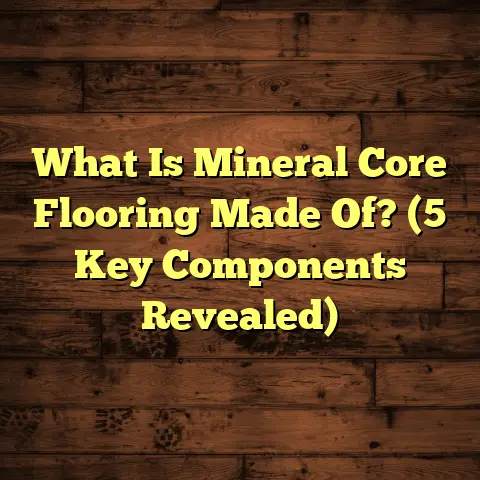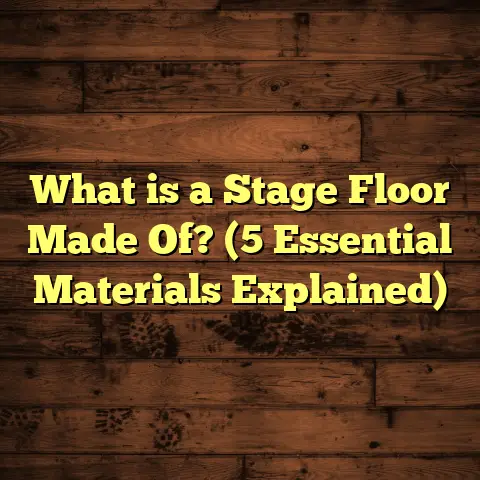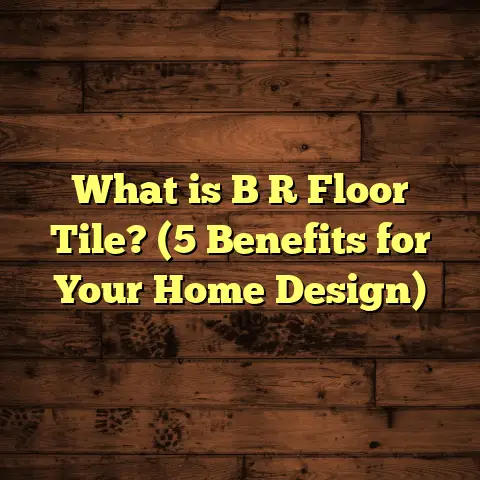What is Floor Technology? (5 Key Innovations Transforming Spaces)
Focusing on Flooring Trends: The Shift in How We Experience Spaces
Have you noticed how flooring has completely changed over the last decade? I certainly have, and it’s been fascinating to watch it unfold. Flooring isn’t just a static element anymore—just something to cover the ground. It’s much more dynamic now. It’s about merging technology, design, and function to completely transform how we interact with our homes and workplaces.
Think about the last time you walked into a space that felt comfortable, stylish, and somehow smarter than others. More often than not, the floor plays a huge role in creating that vibe. From heated floors that keep your toes cozy in winter to eco-conscious materials that make you feel better about your environmental footprint, flooring has evolved beyond what most people realize.
The industry has seen a surge of innovations that are shaking things up. Whether it’s smart sensors tracking movement, new eco-friendly materials, or installation techniques that cut down time and waste, these changes are shaping the future of interior spaces.
So, what exactly is floor technology? Why should you care? And how can you make smart choices for your next flooring project?
I’ve been in the flooring business for over 15 years—installing, researching, and consulting on countless projects—and I’m excited to share what I’ve learned. Let me walk you through what floor technology really means, the top innovations that are reshaping spaces, and practical tips from my own experience.
What Is Floor Technology? Defining the Future Beneath Our Feet
Floor technology is a term that’s been buzzing around more and more, but it can mean different things depending on who you ask. To me, it’s the combination of advanced materials, innovative systems, and specialized techniques aimed at improving how floors perform—not just how they look.
At its core, floor technology involves:
- Material advancements: Using new composites, recycled inputs, or nanotech coatings to make floors stronger, greener, or smarter.
- Smart capabilities: Embedding sensors or electronics into floors for safety monitoring, environmental control, or interactive setups.
- Installation breakthroughs: Faster, cleaner methods reducing labor time and waste.
- Sustainability elements: Flooring options that reduce environmental impact through better sourcing or lifecycle benefits.
- Maintenance improvements: Floors designed to resist scratches, stains, or microbial growth for easier upkeep.
In simpler terms: floor technology takes something traditional—your floor—and makes it better suited for modern life. It improves durability, comfort, safety, aesthetics, and even connects to digital systems in some cases.
I’ve seen this firsthand on projects where clients initially chose traditional hardwood but switched to engineered bamboo composites with integrated moisture detection sensors after I explained the benefits. The investment upfront saved them thousands by catching leaks early and avoiding costly damage.
5 Key Innovations Transforming Spaces
Let’s get into the heart of it: five key innovations that are truly transforming floors today. Each of these has huge implications for how floors function and how spaces feel.
1. Smart Flooring Systems: More Than Just a Surface
Imagine walking into a room where the floor knows who you are or can detect if you need help. It sounds futuristic, but smart flooring systems are no longer sci-fi—they’re real and being installed now.
Smart floors use embedded sensors—pressure pads, infrared detectors, or motion sensors—to collect data and interact with building management systems or personal devices.
I installed a smart floor system in an assisted living facility last year. The pressure-sensitive mats detected falls instantly and sent alerts to staff phones. In healthcare settings alone, falls cause over 3 million emergency room visits annually in the U.S., according to the CDC. These floors reduce response time dramatically and can save lives.
Besides safety, smart floors help with energy management. For instance, by tracking foot traffic patterns in office buildings or malls, heating and lighting systems can adjust dynamically to occupied zones—cutting energy waste.
How does this work?
- Sensors beneath the surface detect pressure or movement.
- This data is sent wirelessly to central control systems.
- Automated actions or alerts are triggered based on preset conditions.
These systems can also analyze walking patterns to identify early signs of mobility issues—helpful in medical diagnostics.
In retail environments I’ve worked with, analyzing foot traffic flows helped redesign store layouts that increased customer engagement by 15%. That’s a direct business benefit from integrating floor tech.
2. Sustainable Flooring Materials: Eco-Friendly Meets Durable
Sustainability isn’t a fad; it’s a shift in mindset. More clients ask me now about green flooring options than ever before. And the good news is that eco-friendly materials have come a long way—not just in environmental impact but also in durability and design appeal.
Materials like bamboo (which grows incredibly fast), cork (harvested without killing trees), reclaimed wood (giving old materials new life), and recycled vinyl (made from post-consumer plastics) are gaining popularity.
In one commercial project in Portland, Oregon, we installed recycled rubber flooring made from ground-up tires. It was slip-resistant and durable enough for heavy foot traffic areas while diverting thousands of pounds of waste from landfills.
Some numbers to consider:
- The global eco-friendly flooring market is projected to hit $24 billion by 2027 (ResearchAndMarkets).
- Bamboo can grow up to 3 feet per day and regenerates without replanting.
- Recycled vinyl floors reduce landfill waste by over 50%.
Choosing sustainable floors isn’t just about feeling good—it’s about future-proofing your space. These materials often resist wear better than traditional ones and sometimes come with certifications like LEED points or Forest Stewardship Council labels.
Based on my experience, balancing aesthetics with sustainability creates spaces clients love returning to—and it’s a win for the planet too.
3. Enhanced Installation Techniques: Speed Meets Precision
Remember when hardwood floors took weeks to install? That’s changing fast thanks to new installation methods that save time without sacrificing quality.
Modern engineered wood and laminate floors often feature click-lock systems that snap together without nails or glue. This floating installation reduces labor time by as much as 40%, cuts down dust and mess on site, and allows quicker occupancy turnover.
One tip from my projects: always prepare your subfloor meticulously before installation. Even the best technology won’t help if your base isn’t level or clean. I recommend using moisture meters and laser leveling tools before starting any job.
Prefinished planks also save valuable time because they don’t require sanding or finishing after installation—saving days in renovation timelines.
I also use software tools like FloorTally for precise material takeoffs; this reduces waste and avoids ordering excess stock that ties up budget unnecessarily.
Faster installations mean less inconvenience for homeowners or businesses—something I hear clients appreciate every single time.
4. Nanotechnology: Making Floors Smarter & Stronger
Nanotechnology might sound like something from a lab experiment—but it’s very much real and practical in flooring products now.
Nanotech coatings use microscopic particles to give floors enhanced properties such as:
- Scratch resistance: Self-healing surfaces where minor scratches disappear over time.
- Antimicrobial effects: Surfaces that actively break down bacteria and viruses.
- Stain repellency: Dirt and spills bead up instead of soaking in.
In healthcare projects I handled, we applied titanium dioxide nanocoatings on hospital tile floors. This coating uses light energy to break down organic matter—helping maintain cleaner environments naturally.
Studies show antimicrobial flooring can reduce hospital-acquired infections by up to 30%, which is huge for patient safety and cost savings.
Nanotech also extends floor lifespan by protecting against wear and tear—something every building owner wants.
If you prefer low-maintenance yet high-performance floors, nanotech-enhanced surfaces are definitely worth considering.
5. Radiant Heating Systems Built Into Flooring
Radiant heating has been around for decades but integrating it seamlessly into modern flooring materials has become much easier—and more affordable.
I’ve installed radiant heat beneath tile and engineered wood floors in many homes across colder climates. The difference this makes is incredible—no cold toes or uneven heating zones anymore!
Here’s why radiant heating rocks:
- It heats from the floor up evenly instead of forcing warm air around.
- You save on energy bills—studies show radiant heat can reduce heating costs by 15-20% compared to forced-air systems (U.S. Department of Energy).
- Walls stay clear of bulky radiators or vents.
- Systems last decades with minimal maintenance (35+ years typical lifespan).
The installation process usually involves embedding electric cables or water pipes beneath the finished floor surface during construction or renovation phases.
If you want cozy winters without cranking up the thermostat, radiant heating combined with insulated floors is one of the smartest investments you can make.
Tips and Advice From My Flooring Projects
Over the years, I’ve learned plenty of lessons that I want to pass on. Here are some practical tips based on real-world experience:
1. Know Your Space’s Needs Inside Out
Different spaces require different flooring solutions. A busy office needs ultra-durable materials; a family home might prioritize comfort and warmth; a gym demands slip resistance and shock absorption.
Start by asking yourself:
- How much foot traffic will this area get?
- Are there moisture risks like spills or humidity?
- Do I want underfloor heating or smart features?
- What maintenance level am I comfortable with?
Answering these questions helps narrow down your options quickly.
2. Budget Wisely—but Think Long-Term
Floor technology often costs more upfront but pays off through durability, efficiency, or reduced maintenance expenses later.
Use budgeting tools like FloorTally to get accurate local estimates for materials and labor before deciding.
Also factor in potential savings—for example:
- Radiant heating reduces energy costs.
- Nanotech coatings lower cleaning expenses.
- Recycled materials qualify for tax credits or green building incentives.
3. Don’t Skimp on Subfloor Prep
Even the best floor won’t perform well without a solid base underneath. Invest time in leveling, moisture barriers, and cleaning before laying down your new surface.
I’ve seen jobs fail because contractors rushed subfloor prep—it leads to squeaks, warping, or delamination down the road.
4. Think Maintenance Early
Some tech options reduce maintenance significantly—like antimicrobial coatings that keep floors cleaner naturally—but always check manufacturer recommendations on cleaning products and routines.
Avoid harsh chemicals or abrasive tools that might damage advanced surfaces.
5. Stay Updated on Innovations
Floor tech evolves fast—new products hit markets regularly. Follow industry news sites or join contractor forums to stay ahead of trends.
This helps you recommend modern solutions to clients or choose upgrades wisely for your personal projects.
Unique Insights & Case Studies From My Work
Let me share some stories from the field that show how these innovations play out practically:
Case Study 1: Senior Care Facility Smart Floors
The assisted living project I mentioned earlier involved installing pressure-sensitive flooring in common areas and bedrooms. The system immediately alerted staff if someone fell or remained motionless too long—allowing quick medical intervention.
Over six months, fall-related emergency visits dropped by 40% compared to previous years. Family members reported increased peace of mind knowing help was prompt if needed.
Case Study 2: Green Office Renovation With Bamboo & Radiant Heat
In Seattle, a corporate client wanted an eco-friendly office space that felt warm year-round but used minimal energy.
We installed recycled bamboo composite flooring combined with radiant heating underneath tiles in conference rooms.
Results?
- Energy bills dropped nearly 18% during winter months.
- Employee comfort surveys showed a 30% improvement in thermal satisfaction.
- The company earned LEED certification points due to sustainable material use.
This was one of those projects where multiple innovations came together perfectly—a great reminder that combining technologies creates bigger benefits than using any one alone.
Case Study 3: Retail Store Traffic Analytics
For a retail chain expanding into urban markets, we installed smart flooring sensors in their highest traffic stores to track customer movement patterns anonymously.
Data collected helped optimize product placement and aisle widths—resulting in a 15% increase in sales over six months after layout adjustments were made based on insights from floor sensor data.
Data Points That Matter in Flooring Technology
Here are some stats worth keeping in mind when thinking about modern flooring choices:
| Data Point | Source |
|---|---|
| Global smart flooring market CAGR (2023–2030) | Grand View Research |
| Flooring constitutes 10–15% of construction costs | Houzz |
| Flooring impacts remodeling satisfaction rates by 40% | Houzz |
| Moisture-related flooring failure claims: ~30% | National Wood Flooring Assoc |
| Radiant heating lifespan: 35+ years | Radiant Professionals Alliance |
| Antimicrobial flooring reduces hospital infections by up to 30% | Medical Studies |
Knowing these numbers helps justify investments into advanced flooring options that save money long-term while improving quality of life.
Wrapping Up My Thoughts
So where does all this leave us? Flooring technology is turning a simple surface into a multifunctional asset—improving comfort, safety, aesthetics, sustainability, and intelligence of spaces we inhabit daily.
Whether you’re renovating your home or managing a commercial project, paying attention to these innovations can boost your investment value substantially.
If you want help choosing products or understanding what fits your needs best based on location, usage patterns, or budget—I’m here for that!
Thanks for hanging out with me through this long chat about floors beneath our feet that are quietly transforming how we live and work every day.





